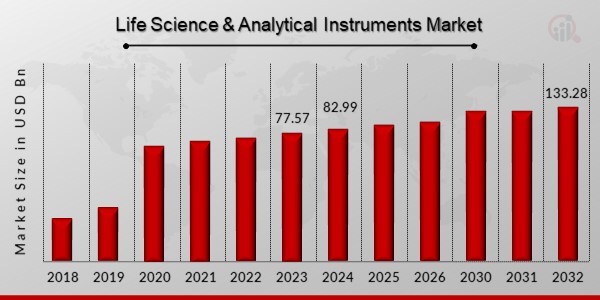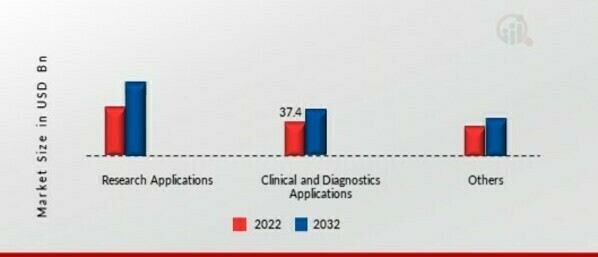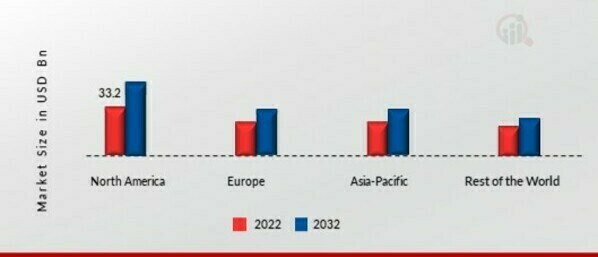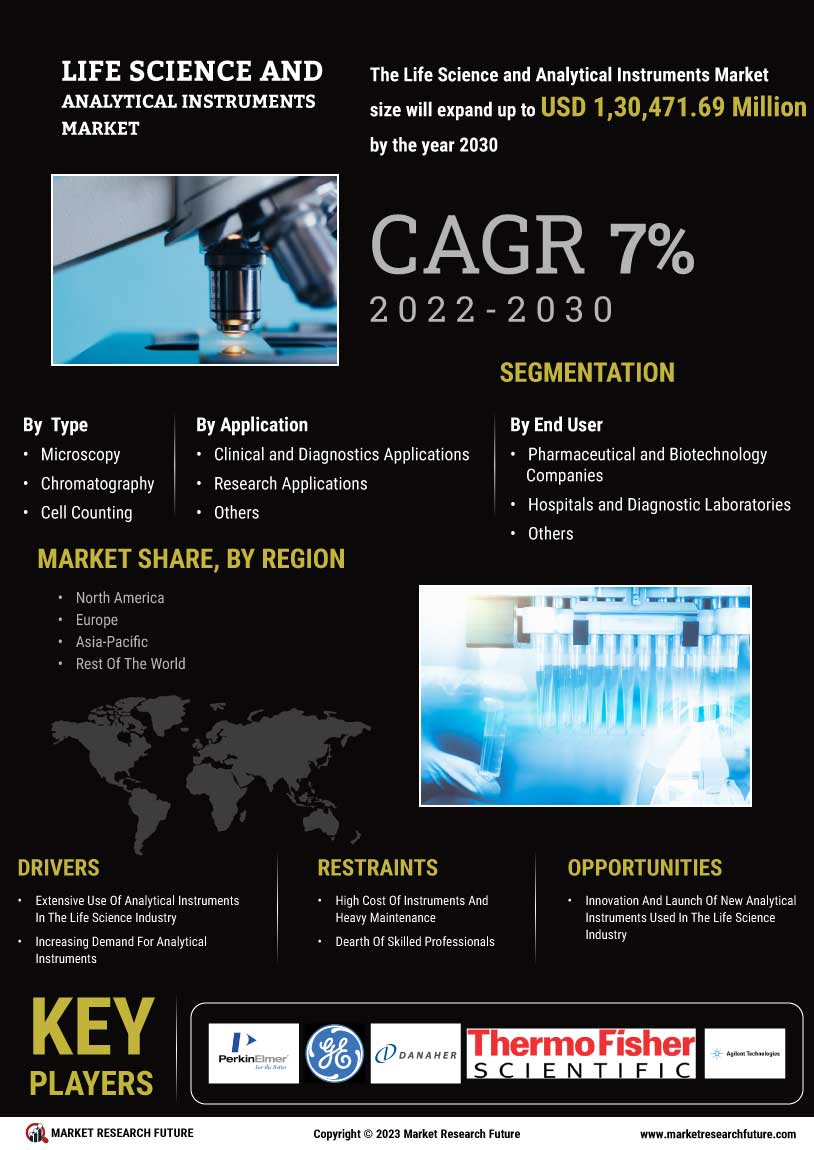Global Life Science & Analytical Instruments Market Overview
The Life Science & Analytical Instruments Market Size was valued at USD 77.57 billion in 2023. The Life Science & Analytical Instruments market industry is projected to grow from USD 82.99 Billion in 2024 to USD 133.28 billion by 2032, exhibiting a compound annual growth rate (CAGR) of 7.32% during the forecast period (2024 - 2032). Increased growth of the proteomics market and rising demand for analytical instruments in different sectorsare the key market drivers enhancing market growth.

Source: Secondary Research, Primary Research, MRFR Database, and Analyst Review
Life Science & Analytical Instruments Market Trends
- Increasing investments in pharmaceutical R&D are driving the market growth
The pharmaceutical industry focuses and invests in research to manufacture protein-related products. Drug development and manufacturing involve different types of analytical instruments. Analytical instruments evaluate drug molecules, protein analysis and purification, and quality control. Protein identification and separation is an important step in drug manufacturing. Technologically advanced equipment helps understand the characterization of a molecule and ensures its safety and purity. Emerging markets have also witnessed a significant increase in foreign direct investment and government investments in pharmaceutical R&D. Thus, increasing R&D spending in the life sciences, pharmaceutical, and biotechnology sectors will likely increase the application usage of life science instruments. This factor drives the market CAGR.
Additionally, various factors are driving the life science and analytical instruments industry market. According to the analytical instrumentation market report, some factors are the increasing demand for safety and quality food, the rapid growth of the proteomics market, and the surge in demand for analytical instruments in different sectors. Moreover, various companies are focusing on improving analytical instruments' usage, and governments are also pushing the market by supporting funds for research and development are also major drivers for the life science & analytical instrumentation market. Furthermore, Life science and analytical tools are largely used to analyze the DNA to discover new pharmaceutical drugs and determine food quality. The companies are largely investing in this field to boost the market. The improvements in new products will increase the opportunity to diagnose the samples accurately. It will help in specification to target the treatment for a particular patient. Analytical instruments find a wide range of applications in food and beverage, environmental testing, and forensic industries. Analytical techniques play an important role in analyzing food materials before, during, and after manufacturing. Pesticides, additives, and other contaminants can be detected with the help of analytical equipment. The instruments also help conduct quality control of packaging materials. Analytical technologies play a crucial role in the environmental testing industry. Different analytical techniques can analyze air and water samples and detect solids, liquid aerosols, trace gases, and volatile organic compounds. A rising focus on environment conservation and preservation has increased the demand for life science instruments and technologies in this application segment. Thus, driving the Life Science & Analytical Instruments market revenue.
Life Science & Analytical Instruments MarketSegment Insights
Life Science & Analytical Instruments Type Insights
The Life Science & Analytical Instruments market segmentation, based on type, includes microscopy, chromatography, cell counting, spectroscopy, PCR, electrophoresis, flow cytometry, centrifuges, and next-generation sequencing. The chromatography segment dominated the market, with its substantial market share and extensive Application in diverse fields. Chromatography is a technique that separates and analyzes components within a mixture based on their distinct chemical properties. Furthermore, technological advancements and the introduction of innovative chromatography systems with enhanced accuracy, efficiency, and automation have further reinforced the segment's dominance. The Chromatography segment assumes a significant role in the Life Science & Analytical Instruments market, providing reliable and versatile solutions for diverse analytical and research applications.
Life Science & Analytical Instruments Application Insights
The Life Science & Analytical Instruments market segmentation, based on application, includes clinical and diagnostics applications, research applications, and others. The clinical and diagnostics applications segment dominated the market, encompassing instruments and technologies used in medical and diagnostic settings to facilitate disease diagnosis, patient monitoring, and drug development. The rising demand for advanced clinical and diagnostic instruments is due to the rising prevalence of diseases like cancer, HIV. Secondly, continuous advancements in medical research and the growing focus on personalized medicine have led to the development of sophisticated instruments for precise analysis and testing. Additionally, government initiatives and investments in healthcare infrastructure further boost the demand for clinical and diagnostic applications.
Figure1: Life Science & Analytical Instruments Market, by Application, 2022 & 2032 (USD billion)

Source: Secondary Research, Primary Research, MRFR Database, and Analyst Review
Life Science & Analytical Instruments End User Insights
The Life Science & Analytical Instruments market segmentation, based on end user, includes pharmaceutical and biotechnology companies, hospitals and diagnostic laboratories, others. The pharmaceutical and biotechnology segment dominated the market; pharmaceutical and biotechnology companies are instrumental in drug discovery, development, and production, necessitating the utilization of advanced analytical instruments for various processes, including quality control, formulation, and testing. The demand for life science and analytical instruments arises from the requirement for accurate and efficient analysis, ensuring product safety and adherence to regulatory standards. Additionally, the growing focus on precision medicine, personalized therapies, and the increasing prevalence of chronic diseases have further propelled the demand for life science and analytical instruments in these sectors. Overall, the dominance of the Pharmaceutical and Biotechnology Companies segment in the Life Science & Analytical Instruments market stems from the industry's extensive research and manufacturing activities and the necessity for advanced analytical solutions.
Life Science & Analytical Instruments Regional Insights
By Region, the study provides market insights into North America, Europe, Asia-Pacific, and Rest of the World. The North American Life Science & Analytical Instruments market area will dominate this market; the rising prevalence of chronic diseases like cancer and other lifestyle-related disorders has resulted in an increased demand for life science and analytical instruments. Also, technological developments in diagnostic systems and the increasing population of the older population are the major factors for the growth of this Region's life science and analytical instruments industry.
Further, the major countries studied in the market report are The U.S., Canada, German, France, the U.K., Italy, Spain, China, Japan, India, Australia, South Korea, and Brazil.
Figure2: Life Science & Analytical Instruments Market Share By Region 2022 (%)

Source: Secondary Research, Primary Research, MRFR Database, and Analyst Review
Europe's Life Science & Analytical Instruments market accounts for the second-largest market share because of thegrowing pharmaceutical and biotechnological industry, increasing awareness and clinical trials, and the influence of academic and research institutions, which are the major drivers of the laboratory analytical instruments market in this Region. Further, the GermanLife Science & Analytical Instruments market held the largest market share, and the U.K. Life Science & Analytical Instruments market was the fastest-growing market in the European Region.
The Asia-Pacific Life Science & Analytical Instruments Market is expected to grow fastest from 2024 to 2032. This is due torapid life science and analytical instruments industry developments. It is observed that the increasing cases of chronic diseases like cancer, diabetes, and HIV will influence the market to boost. Moreover, China’s Life Science & Analytical Instruments market held the largest market share, and the IndianLife Science & Analytical Instruments market was the fastest-growing market in the Asia-Pacific region.
Life Science & Analytical Instruments Key Market Players& Competitive Insights
Leading market players are investing heavily in research and development to expand their product lines, which will help the Life Science & Analytical Instruments market grow even more. Market participants are also undertaking various strategic activities to expand their footprint, with important market developments including new product launches, contractual agreements, mergers and acquisitions, higher investments, and collaboration with other organizations. To expand and survive in a more competitive and rising market climate, Life Science & Analytical Instruments industry must offer cost-effective items.
Manufacturing locally to minimize operational costs is one of the key business tactics manufacturers use in the Life Science & Analytical Instruments industry to benefit clients and increase the market sector. In recent years, the Life Science & Analytical Instruments industry has offered some of the most significant advantages. Major players in the Life Science & Analytical Instruments market, including PerkinElmer, Inc. (the U.S.), General Electric Company (U.S.), Danaher (U.S.), Thermo Fisher Scientific (U.S.), Agilent Technologies Inc. (U.S.), Qiagen (Germany), Shimadzu Corporation (Japan), Becton, Dickinson and Company (U.S.), Merck KGAA (Germany)., and others, are attempting to increase market demand by investing in research and development operations.
Thermo Fisher Scientific Inc. is an American supplier of scientific instrumentation, reagents and consumables, and software services. Thermo Fisher was formed in Waltham, Massachusetts, by merging Thermo Electron and Fisher Scientific in 2006. Thermo Fisher Scientific introduced a new trace elemental analyzer. The Thermo Scientific iCAPRQplus ICP-MS Analyzer can be used in the pharmaceutical, food, and environmental sectors. It can be used for different sample types and trace elements at low concentrations.
Agilent Technologies, Inc. is a company that provides various instruments, software, services, and laboratory consumables. The company originated in 1999 as a spin-off from Hewlett-Packard.Recently, Agilent Technologies, Inc. introduced GC/MS and LC/MS quadrupole mass spectrometers designed to simplify laboratory operations and address the primary challenges customers face. These innovative products aim to enhance efficiency and effectiveness in laboratory settings.
Key CompaniesIn The Life Science & Analytical Instruments Market Include
- PerkinElmer Inc. (the U.S.)
- General Electric Company (U.S.)
- Danaher (U.S.)
- Thermo Fisher Scientific (U.S.)
- Agilent Technologies Inc. (U.S.)
- Qiagen (Germany)
- Shimadzu Corporation (Japan)
- Becton Dickinson and Company (U.S.)
Life Science & Analytical Instruments Industry Developments
March 2023:Thermo Fisher Scientific Inc (US) has introduced the Thermo Scientific iCAP RQplus ICP-MS Analyzer, a new trace elemental analyzer that simplifies everyday analyses in environmental, food, pharmaceutical and industrial testing laboratories
Shimadzu Corporation (Japan) unveiled the Nexera UC. With this superficial fluid extraction/chromatography system, separation and detection power are improved.
Life Science & Analytical Instruments Market Segmentation
Life Science & Analytical Instruments Type Outlook
- Microscopy
- Chromatography
- Cell Counting
- Spectroscopy
- PCR
- Electrophoresis
- Flow cytometry
- Centrifuges
- Next-Generation Sequencing
- Others
Life Science & Analytical Instruments Application Outlook
- Clinical and Diagnostics Applications
- Research Applications
- Others
Life Science & Analytical Instruments End User Outlook
- Pharmaceutical and Biotechnology Companies
- Hospitals and Diagnostic Laboratories
- Others
Life Science & Analytical Instruments Regional Outlook
-
Germany
-
France
-
UK
-
Italy
-
Spain
-
Rest of Europe
-
Asia-Pacific
-
China
-
Japan
-
India
-
Australia
-
South Korea
-
Australia
-
Rest of Asia-Pacific
-
Rest of the World
-
Middle East
-
Africa
-
Latin America
| Report Attribute/Metric |
Details |
| Market Size 2023 |
USD 77.57 billion |
| Market Size 2024 |
USD 82.99 billion |
| Market Size 2032 |
USD 133.28 billion |
| Compound Annual Growth Rate (CAGR) |
7.32% (2024-2032) |
| Base Year |
2023 |
| Market Forecast Period |
2024-2032 |
| Historical Data |
2018- 2022 |
| Market Forecast Units |
Value (USD Billion) |
| Report Coverage |
Revenue Forecast, Market Competitive Landscape, Growth Factors, and Trends |
| Segments Covered |
Type, Application,End User, and Region |
| Geographies Covered |
North America, Europe, AsiaPacific, and the Rest of the World |
| Countries Covered |
The U.S., Canada, German, France, UK, Italy, Spain, China, Japan, India, Australia, South Korea, and Brazil |
| Key Companies Profiled |
PerkinElmer, Inc. (the U.S.), General Electric Company (U.S.), Danaher (U.S.), Thermo Fisher Scientific (U.S.), Agilent Technologies, Inc. (U.S.), Qiagen (Germany), Shimadzu Corporation (Japan), Becton, Dickinson, and Company (U.S.), Merck KGAA (Germany) |
| Key Market Opportunities |
The improvements in new products will increase the opportunity to diagnose the samples accurately. |
| Key Market Dynamics |
The rapid growth of the proteomics market |
Life Science & Analytical Instruments Market Highlights:
Frequently Asked Questions (FAQ) :
The Life Science & Analytical Instruments market size was valued at USD 72.5 Billion in 2022.
The market is estimated to grow at a CAGR of 7.32%during the forecast period, 2024-2032.
North America had the largest share of the market
The key players in the market are PerkinElmer, Inc. (the U.S.), General Electric Company (U.S.), Danaher (U.S.), Thermo Fisher Scientific (U.S.), Agilent Technologies, Inc. (U.S.), Qiagen (Germany), Shimadzu Corporation (Japan), Becton, Dickinson and Company (U.S.), Merck KGAA (Germany).
The Chromatography Life Science & Analytical Instruments category dominated the market in 2022.
The Clinical and Diagnostics Applications had the largest share in the market.





























